Improved Theoretical Solutions for Estimating the Tunnel Response Induced by Overlying Excavation
Abstract
:1. Introduction
2. Establishment of Theoretical Method
2.1. The Calculation of Unloading Stress
2.2. Theoretical Solution for Tunnel Deformation
- (1)
- The existing tunnel can be idealized as a Euler–Bernoulli beam and the soil–tunnel interaction can be simulated as three-parameters Kerr-model.
- (2)
- The unloading stress due to foundation pit excavation is estimated by Mindlin’s formula, ignoring the influence of the existing tunnel.
- (3)
- The existing tunnel and the surrounding soil are co-deformed and have no local separation between them.
- (4)
- The influence of ground water and the variation of soil properties are ignored in this study.
2.3. Determination of Parameters of Kerr-Model
3. Verification of This Study
3.1. Comparing with FEM Method
3.2. Comparing with Measurements in Shanghai
4. Discussion
4.1. Tunnel-Excavation Horizontal Distance
4.2. Tunnel Bending Stiffness
4.3. Tunnel Depth
5. Conclusions
Author Contributions
Funding
Institutional Review Board Statement
Informed Consent Statement
Data Availability Statement
Conflicts of Interest
References
- Chang, C.; Sun, C.; Duann, S.; Richard, N. Response of a Taipei Rapid Transit System (TRTS) tunnel to adjacent excavation. Tunn. Undergr. Space Technol. 2001, 16, 151–158. [Google Scholar] [CrossRef]
- Hu, Z.; Yue, Z.; Zhou, J.; Tham, L.G. Design and construction of a deep excavation in soft soils adjacent to the Shanghai Metro tunnels. Can. Geotech. J. 2003, 40, 933–948. [Google Scholar] [CrossRef]
- Wang, J.; Xu, Z.; Wang, W. Wall and Ground Movements due to Deep Excavations in Shanghai Soft Soils. J. Geotech. Geo-Environ. Eng. 2010, 136, 985–994. [Google Scholar] [CrossRef]
- Khoiri, M.; Ou, C.Y. Evaluation of deformation parameter for deep excavation in sand through case histories. Comput. Geotech. 2013, 47, 57–67. [Google Scholar] [CrossRef]
- Cao, C.; Shi, C.; Lei, M.; Peng, L.; Bai, R. Deformation Characteristics and Countermeasures of shallow and Large-span Tunnel Under-crossing the Existing Highway in Soft Soil: A Case Study. SCE J. Civ. Eng. 2018, 22, 3170–3181. [Google Scholar] [CrossRef]
- Zheng, G.; Wei, S.; Peng, S.; Diao, Y.; Ng, C.W. Centrifuge modeling of the influence of basement excavation on existing tunnels. In Proceedings of the International Conference on Physical Modelling in Geotechnics, Zurich, Switzerland, 28 June–1 July 2010; Volume 1, pp. 523–527. [Google Scholar]
- Ng, C.W.; Shi, J.; Hong, Y. Three-dimensional centrifuge modelling of basement excavation effects on an existing tunnel in dry sand. Can. Geotech. J. 2013, 50, 874–888. [Google Scholar] [CrossRef]
- Chen, Y. Research on the Heave Displacement of Tunnel Induced by Foundation pit. Master’s Thesis, Tongji University, Shanghai, China, 2005. [Google Scholar]
- Liu, H.; Li, P.; Liu, J. Numerical investigation of underlying tunnel heave during a new tunnel construction. Tunn. Undergr. Space Technol. 2011, 26, 276–283. [Google Scholar] [CrossRef]
- Zheng, G.; Wei, S. Numerical analyses of influence of overlying pit excavation on existing tunnels. J. Cent. South Univ. Technol. 2008, 15, 69–75. [Google Scholar] [CrossRef]
- Shi, J.; Ng, C.W.; Chen, Y. Three-dimensional numerical parametric study of the influence of basement excavation on existing tunnel. Comput. Geotech. 2015, 63, 146–158. [Google Scholar] [CrossRef]
- Shi, C.; Cao, C.; Lei, M.; Peng, L.; Ai, H. Effects of lateral unloading on the mechanical and deformation performance of shield tunnel segment joints. Tunn. Undergr. Space Technol. 2016, 51, 175–188. [Google Scholar] [CrossRef]
- Huang, H.; Huang, X.; Schweiger, H.F. Numerical analysis of the influence of deep excavation on underneath existing road tunnel. Chin. Civ. Eng. J. 2012, 45, 182–189. [Google Scholar]
- Afifipour, M.; Sharifzadeh, M.; Shahriar, K.; Jamshidi, H. Interaction of twin tunnels and shallow foundation at Zand underpass, Shiraz metro, Iran. Tunn. Undergr. Space Technol. 2011, 26, 356–363. [Google Scholar] [CrossRef]
- Liao, S.; Peng, F.; Shen, S. Analysis of shearing effect on tunnel induced by load transfer along longitudinal direction. Tunn. Undergr. Space Technol. 2008, 23, 421–430. [Google Scholar] [CrossRef]
- Zhang, Z.; Zhang, M.; Wang, W. Two-stage method for analyzing effects on adjacent metro tunnels due to foundation pit excavation. Rock Soil Mech. 2011, 32, 2085–2092. [Google Scholar]
- Zhang, Z.; Huang, M. Boundary element model for analysis of the mechanical behavior of existing pipelines subjected to tunneling-induced deformations. Comput. Geotech. 2012, 81, 93–103. [Google Scholar] [CrossRef]
- Zhang, Z.; Huang, M.; Wang, W. Evaluation of deformation response for adjacent tunnels due to soil unloading in excavation engineering. Tunn. Undergr. Space Technol. 2013, 38, 244–253. [Google Scholar] [CrossRef]
- Feng, G.; Xu, C.; Liang, L.; Tey, M.; Chi, M.; Ge, S. Simplified method for evaluating the response of existing tunnel induced by adjacent excavation. Int. J. Numer. Anal. Methods Geomech. 2023, 47, 54–81. [Google Scholar] [CrossRef]
- Liang, R.; Xia, T.; Huang, M.; Lin, C. Simplified method for evaluating the effects of adjacent excavation on shield tunnel considering the shearing effect. Comput. Geotech. 2017, 81, 167–187. [Google Scholar] [CrossRef]
- Liang, R.; Wu, W.; Yu, F.; Jiang, G.; Liu, J. Simplified method for evaluating shield tunnel deformation due to adjacent excavation. Tunn. Undergr. Space Technol. 2018, 71, 94–105. [Google Scholar] [CrossRef]
- Mindlin, R.D. Force at a Point in the Interior of a Semi-Infinite Solid. Physics 1936, 7, 195–202. [Google Scholar] [CrossRef]
- Winkler, E. Die Lehre von der Elastizitat und Festigkeit (The Theory of Elasticity and Stiffness); Dominicus Prague: Czechoslovakia, Germany, 1867. [Google Scholar]
- Pasternak, P.L. On a New Method of Analysis of an Elastic Foundation by Means of Two Foundation Constants; Gosudarstvennoe Izdatelstvo Literaturi po Stroitelstvu I Arkhitekture: Moscow, Russia, 1954. [Google Scholar]
- Wu, H.; Shen, S.; Liao, S.; Yin, Z. Longitudinal structural modelling of shield tunnels considering shearing dislocation between segmental rings. Tunn. Undergr. Space Technol. 2015, 50, 317–323. [Google Scholar] [CrossRef]
- Wu, H.; Shen, S.; Yang, J.; Zhou, A. Soil-tunnel interaction modelling for shield tunnels considering shearing dislocation in longitudinal joints. Tunn. Undergr. Space Technol. 2018, 78, 168–177. [Google Scholar] [CrossRef]
- Liu, J.; Shi, C.; Lei, M.; Cao, C.; Lin, Y. Improved analytical method for evaluating the responses of a shield tunnel to adjacent excavations and its application. Tunn. Undergr. Space Technol. 2020, 98, 103339. [Google Scholar] [CrossRef]
- Vlasov, V.Z.; Leontev, U.N. Beams, Plates and Shells on Elastic Foundations; Israel Program for Scientific Translations: Jerusalem, Russia, 1966. [Google Scholar]
- Kerr, A.D. Elastic and viscoelastic foundation models. Appl. Mech. 1964, 25, 491–498. [Google Scholar] [CrossRef]
- Kerr, A.D. A study of a new foundation model. Acta Mech. 1965, 1, 135–147. [Google Scholar] [CrossRef]
- Kerr, A.D. On the determination of foundation model parameters. Geotech. Engrg. 1985, 111, 1334–1340. [Google Scholar] [CrossRef]
- Hetenyi, M. A general solution for the bending of beams on an elastic foundation of arbitrary continuity. J. Appl. Phys. 1950, 21, 55–58. [Google Scholar] [CrossRef]
- Reissner, E. Note on the formulation of the problem of the plate on an elastic foundation. Acta Mech. 1967, 4, 88–91. [Google Scholar] [CrossRef]
- Avramidis, I.E.; Konstantinos, M. Bending of beams on three-parameter elastic foundation. Int. J. Solids Struct. 2006, 43, 357–375. [Google Scholar] [CrossRef] [Green Version]
- Shiba, Y.; Kawashima, K.; Obinata, N. Evaluation method of longitudinal stiffness of shield tunnel linings for application to seismic response analysis. Proc. Jpn. Soc. Civil Eng. 1988, 398, 319–327. [Google Scholar]
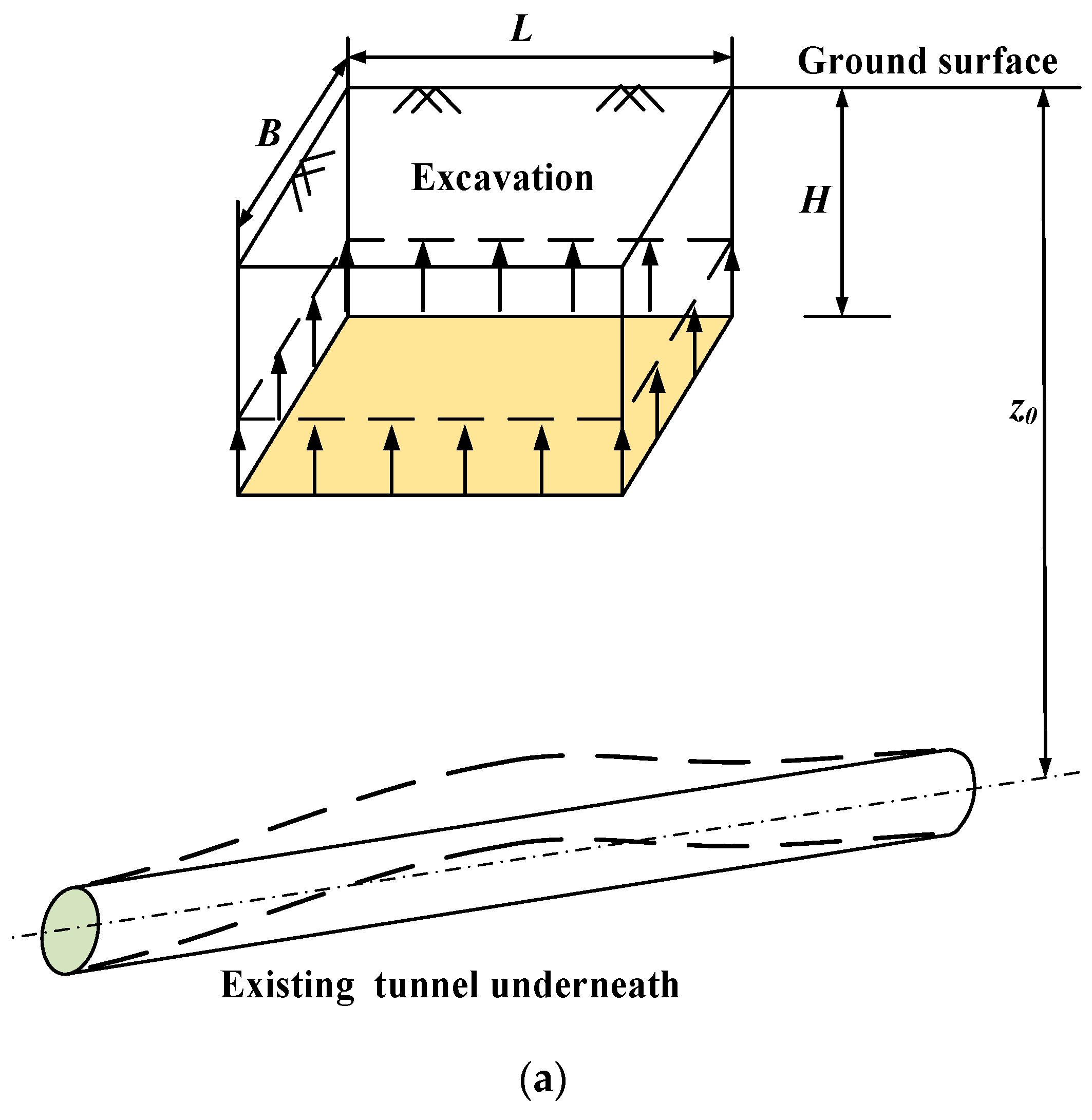
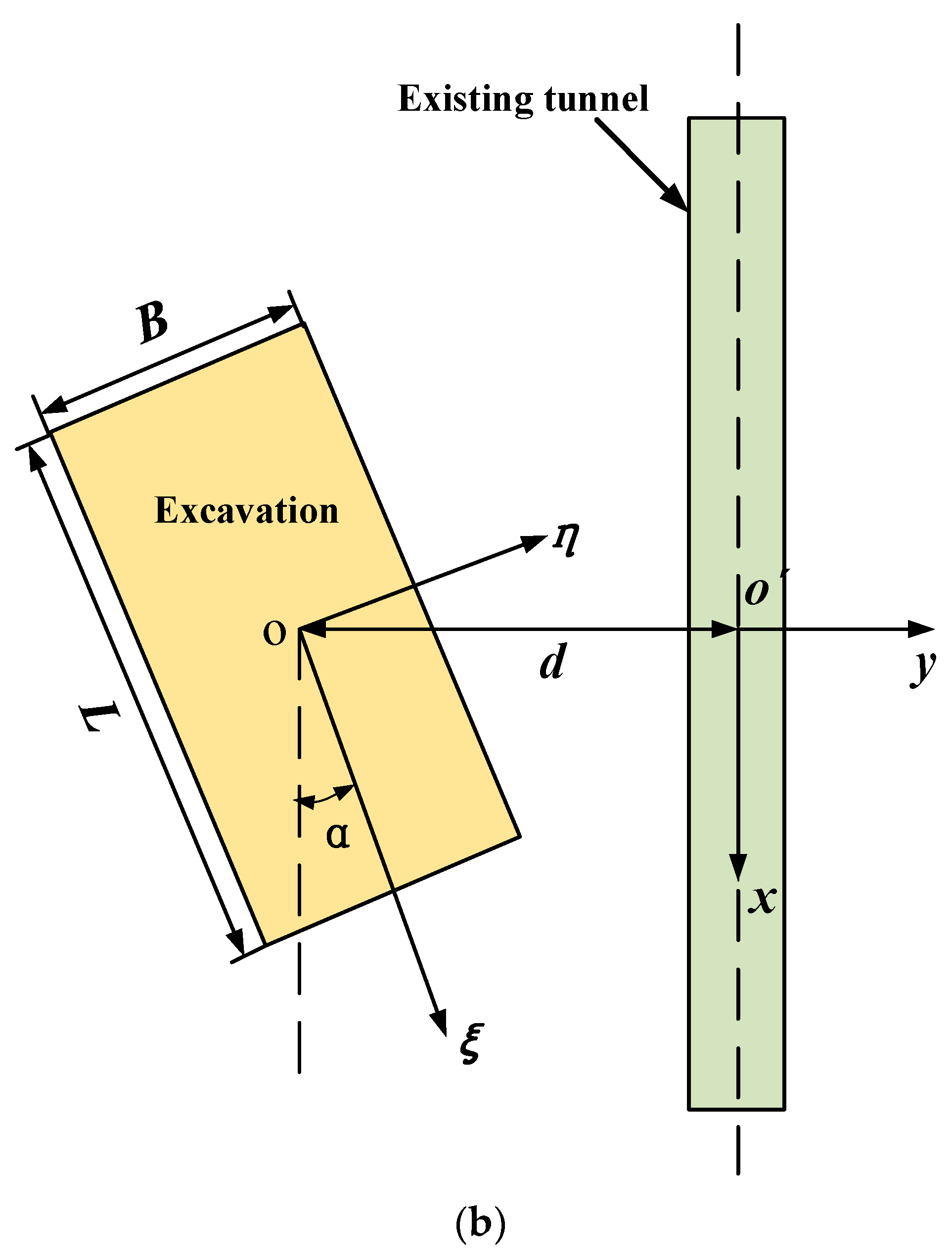
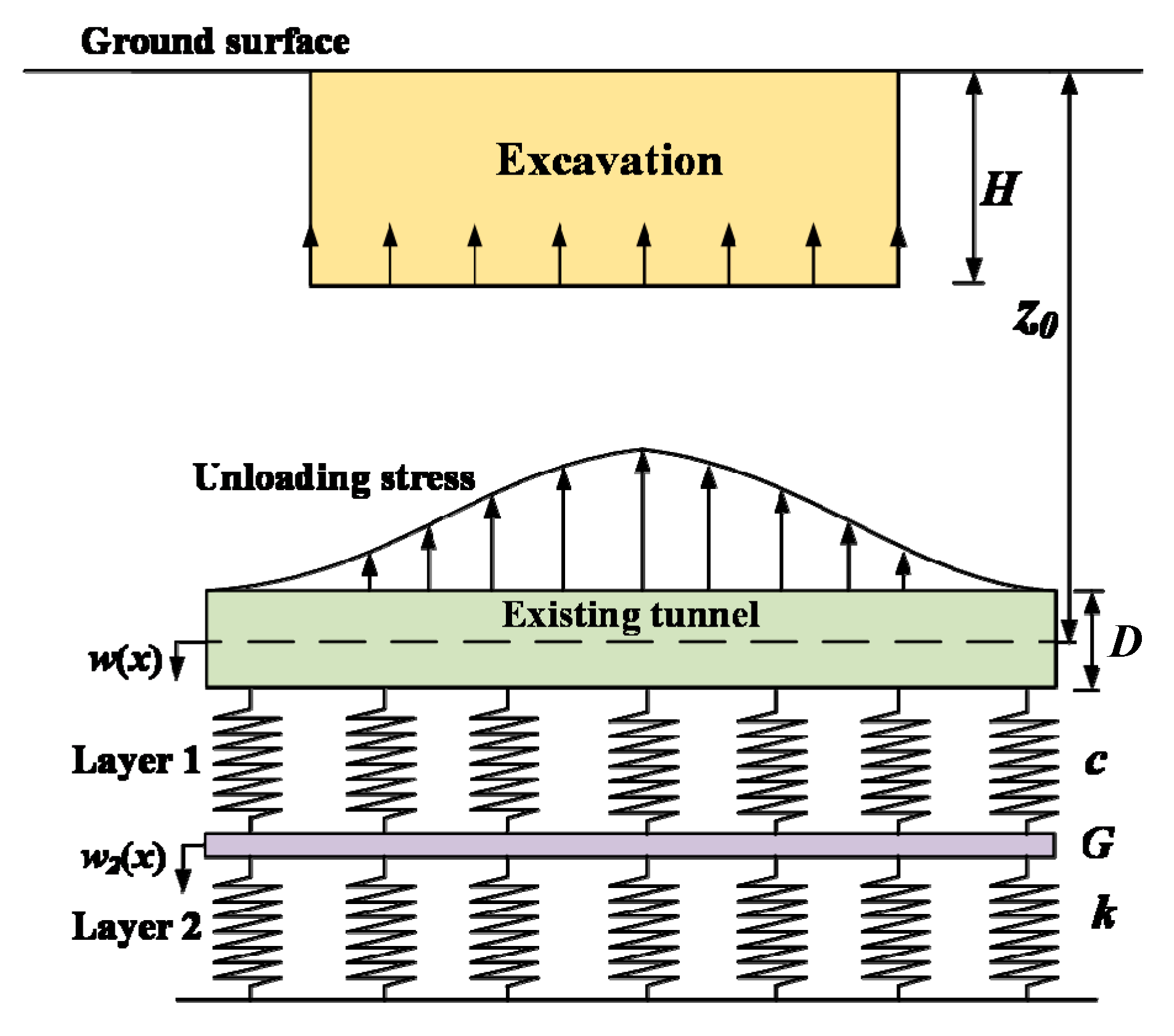


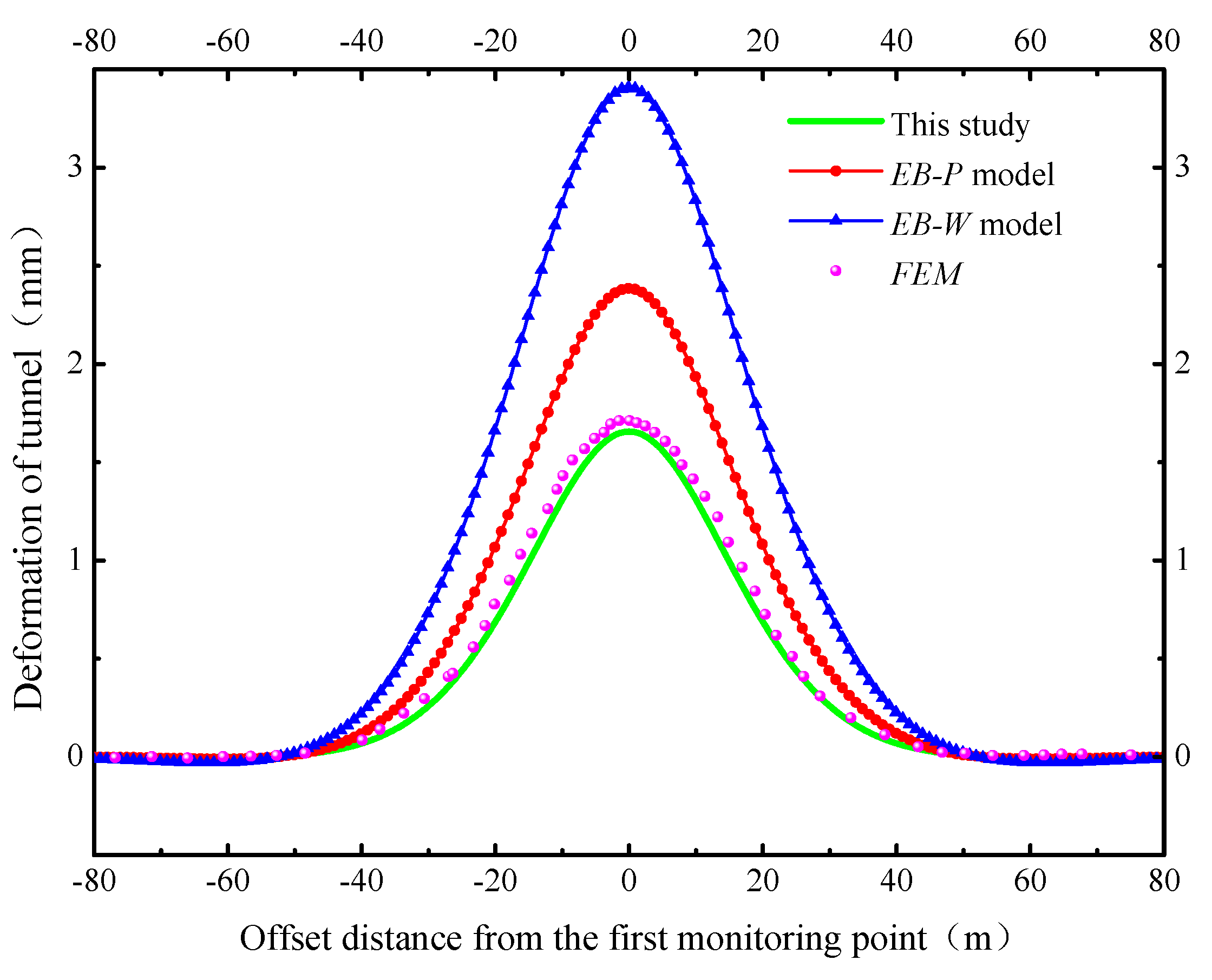

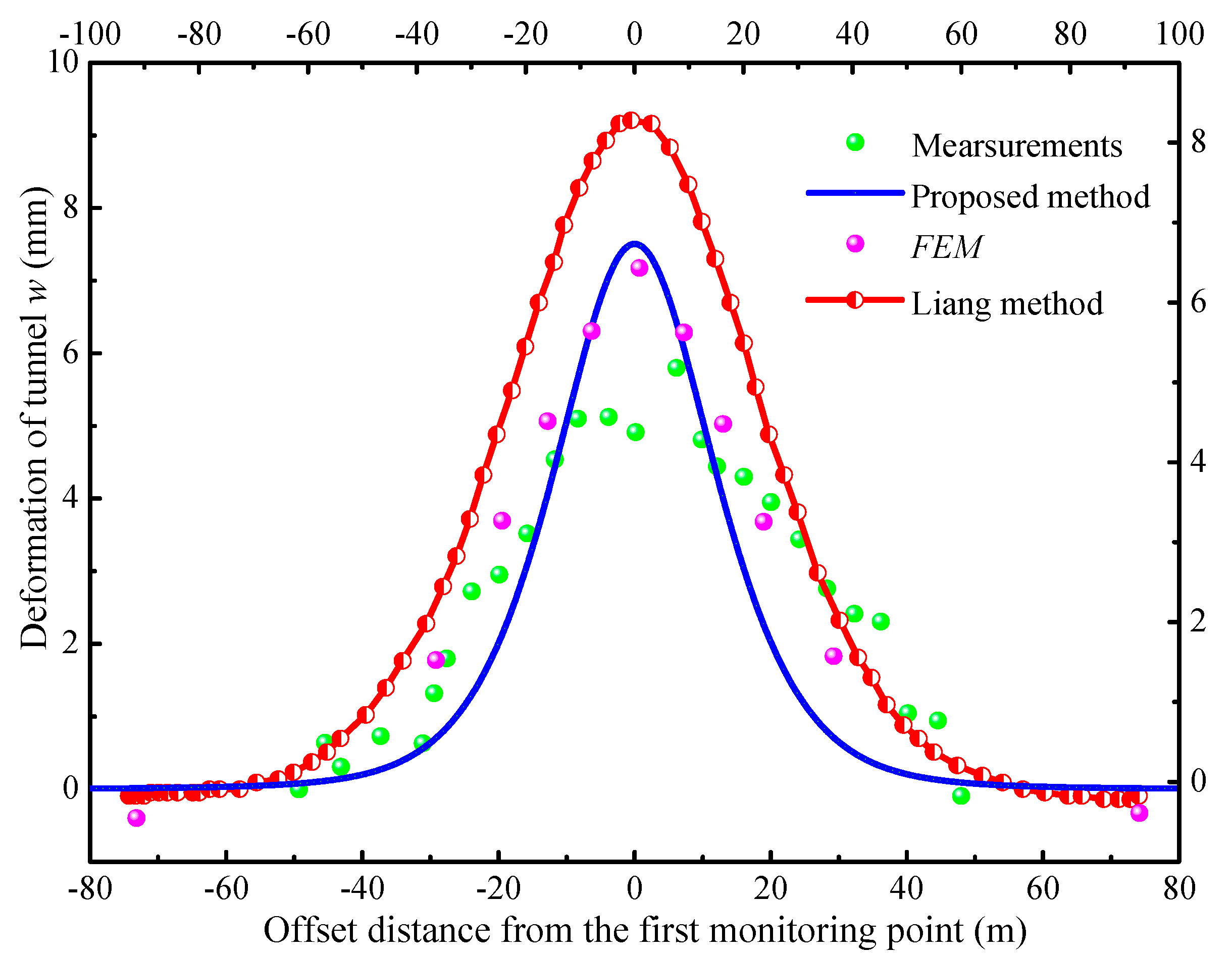
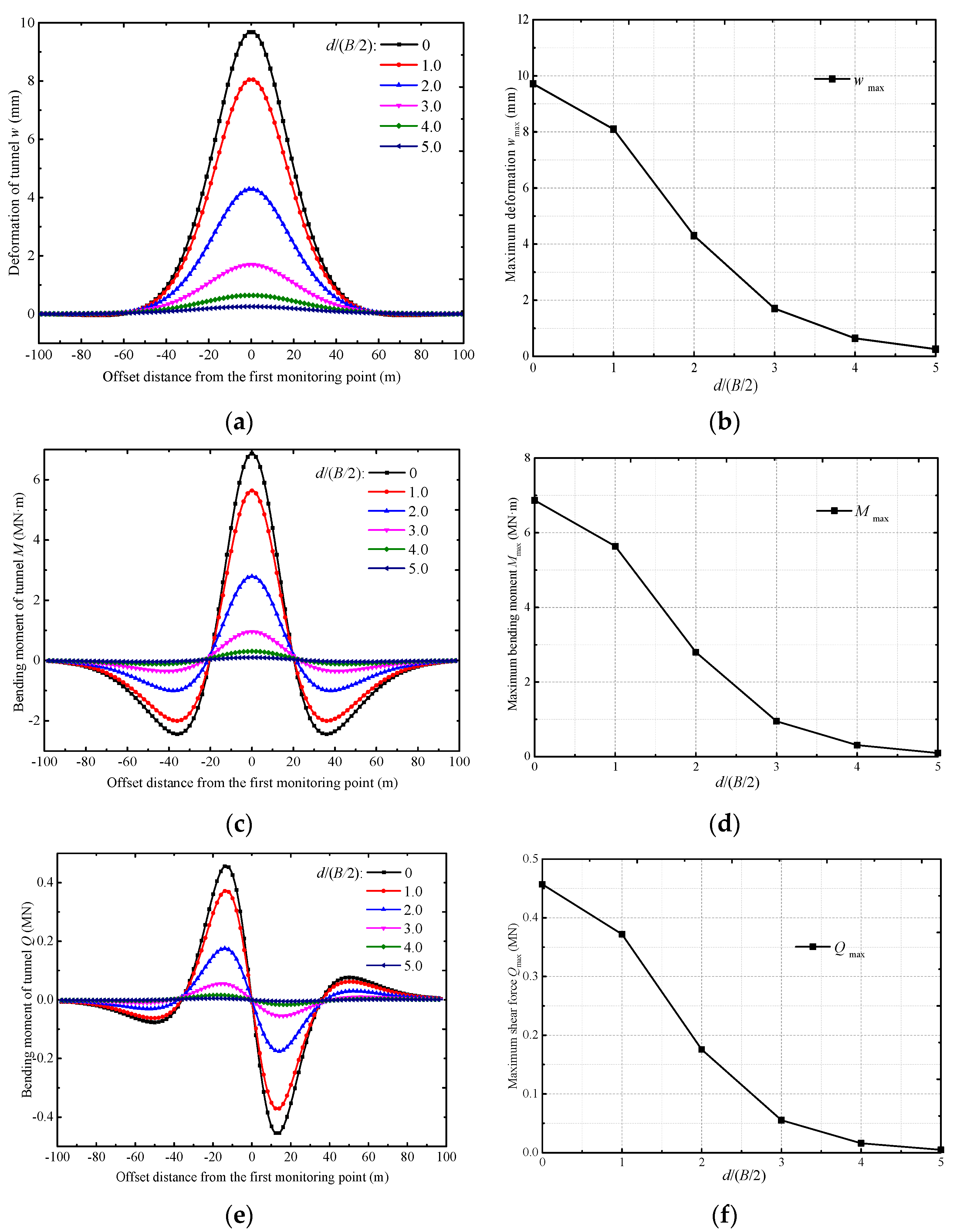
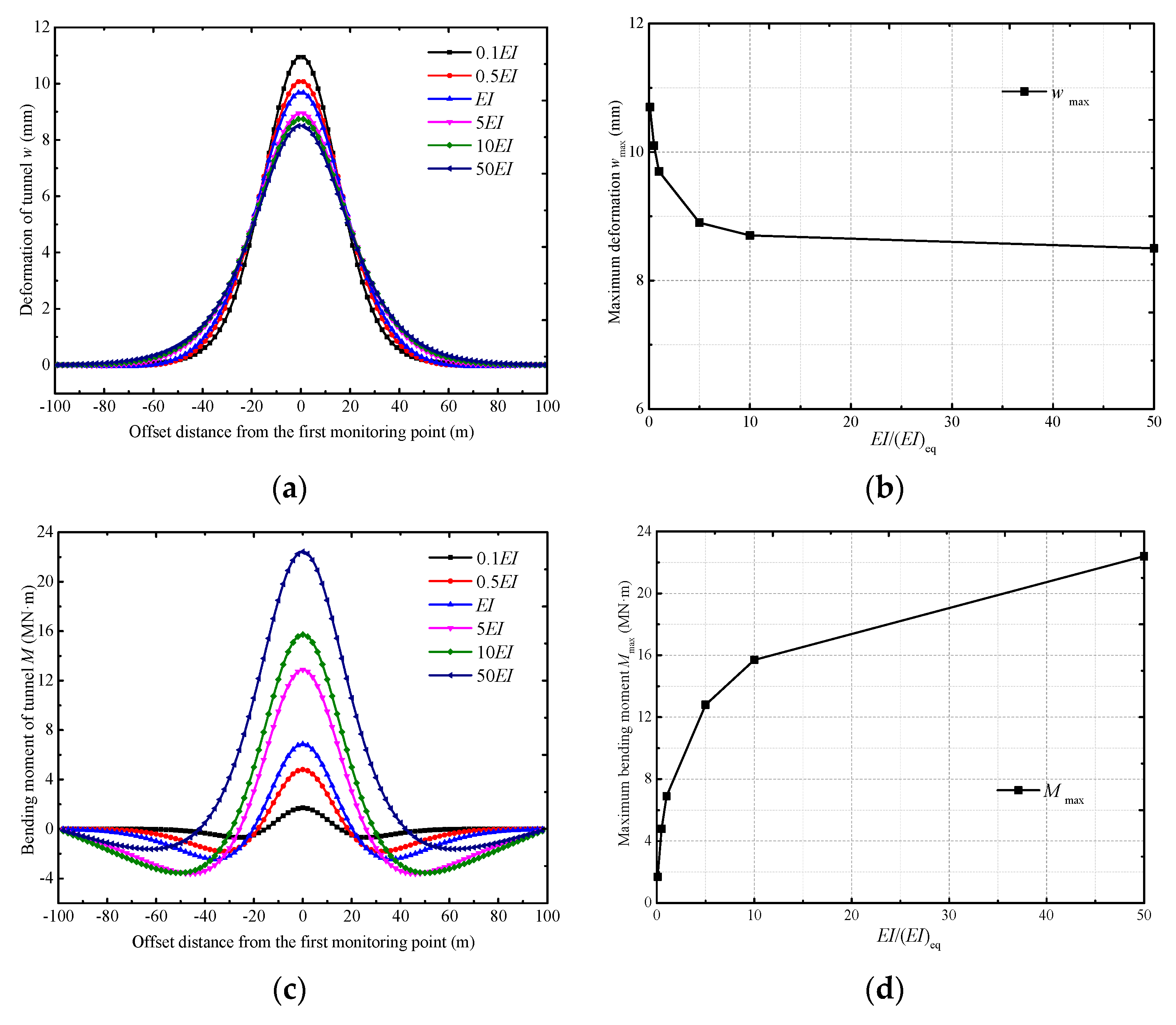
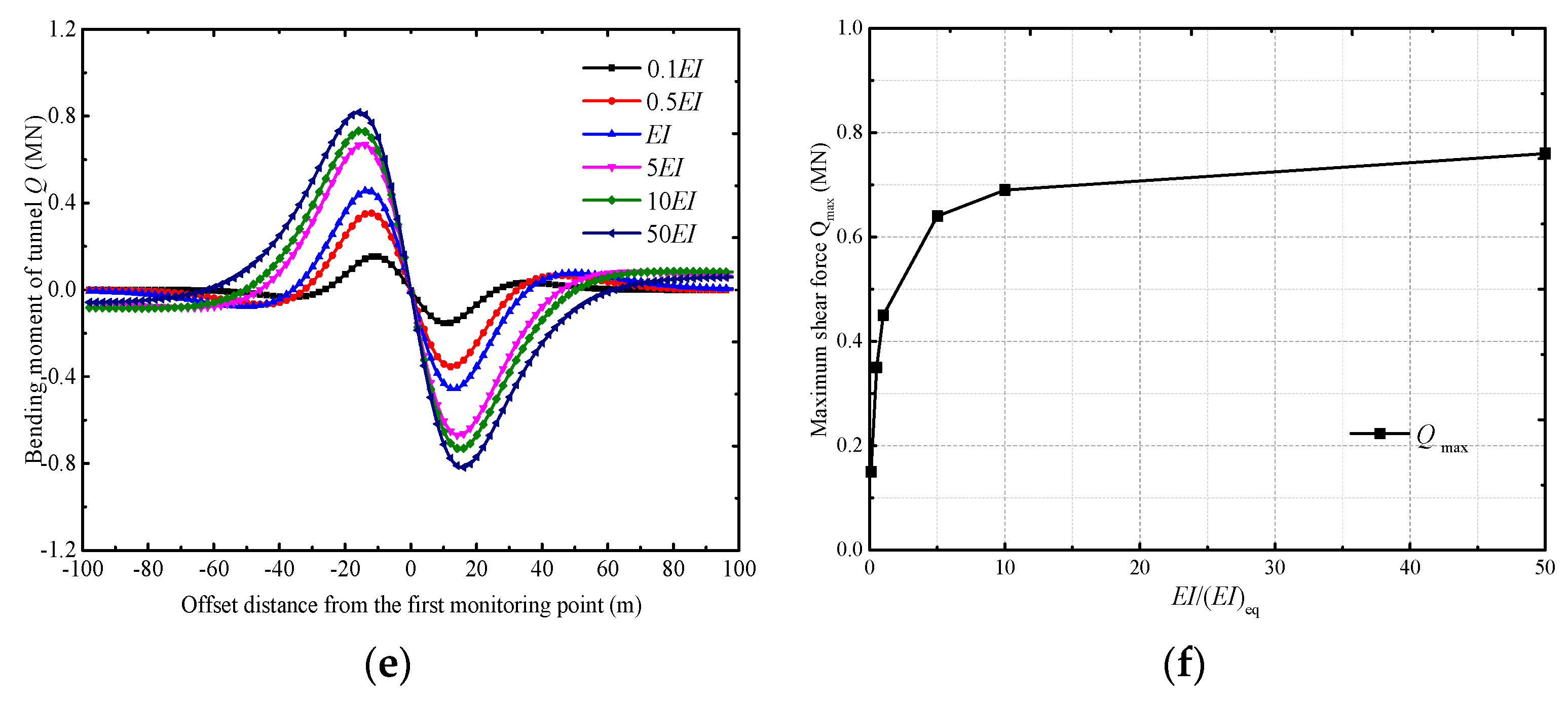
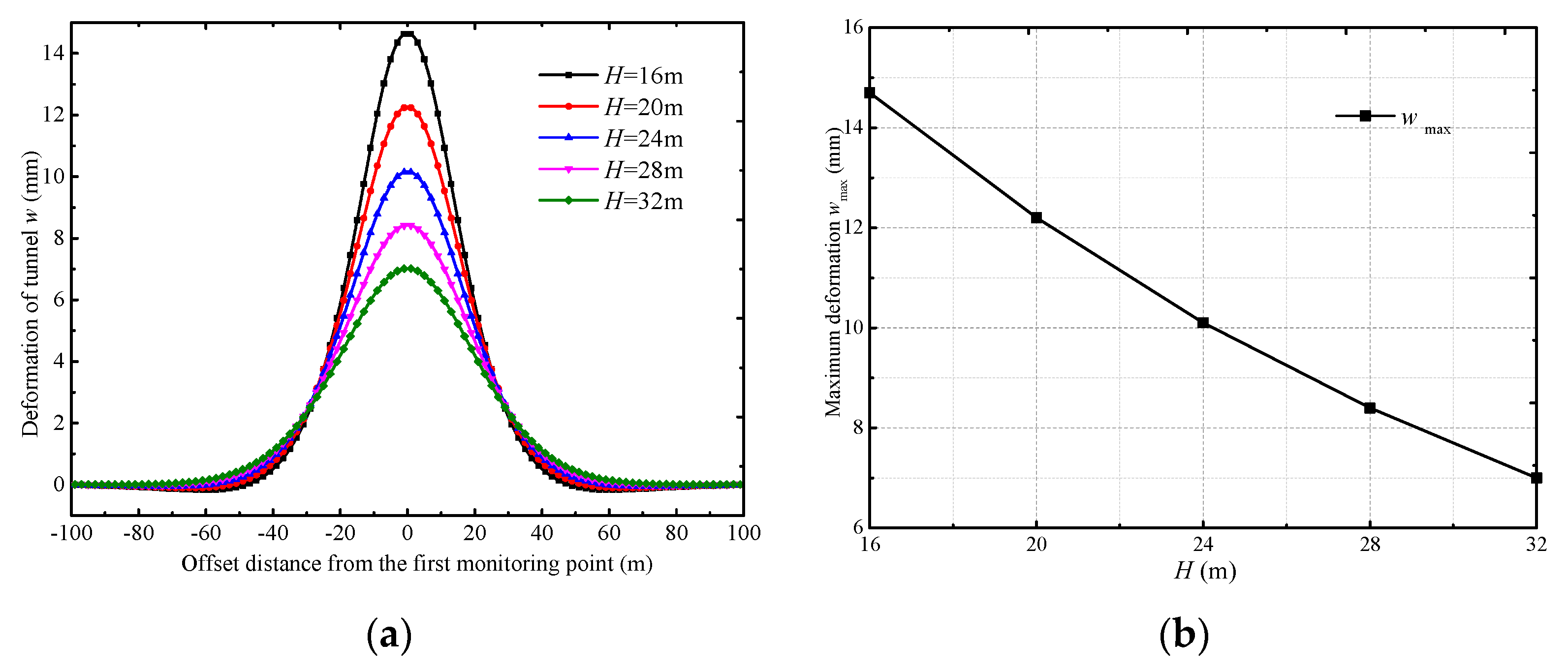
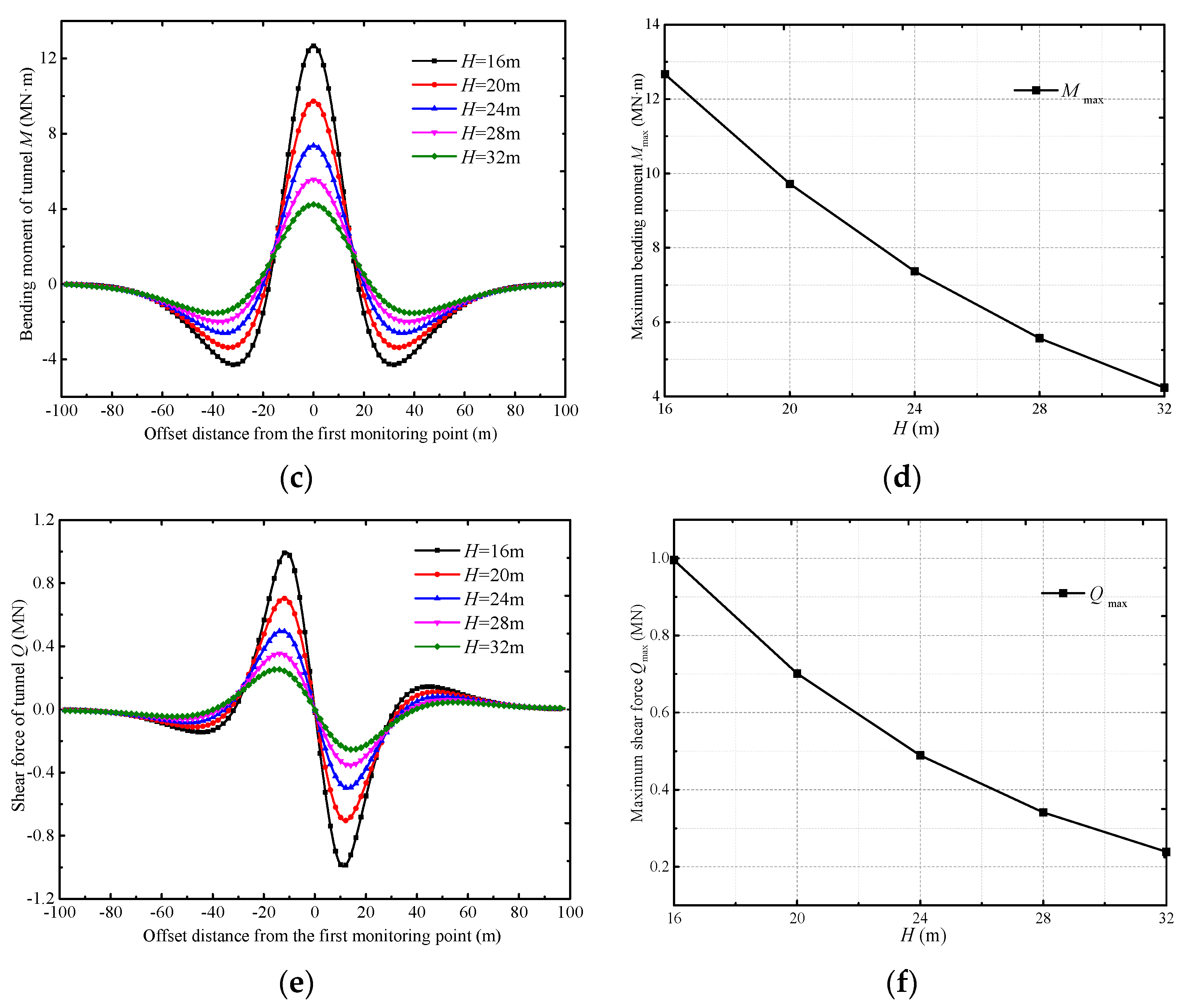
| D/m | z0/m | ES/MPa | υ | EI/(MN•m2) |
|---|---|---|---|---|
| 6.2 | 25 | 15 | 0.33 | 7.8 × 104 |
| D/m | z0/m | ES/MPa | υ | EI/(MN•m2) |
|---|---|---|---|---|
| 11 | 35 | 30.8 | 0.33 | 3.99 × 105 |
Disclaimer/Publisher’s Note: The statements, opinions and data contained in all publications are solely those of the individual author(s) and contributor(s) and not of MDPI and/or the editor(s). MDPI and/or the editor(s) disclaim responsibility for any injury to people or property resulting from any ideas, methods, instructions or products referred to in the content. |
© 2023 by the authors. Licensee MDPI, Basel, Switzerland. This article is an open access article distributed under the terms and conditions of the Creative Commons Attribution (CC BY) license (https://creativecommons.org/licenses/by/4.0/).
Share and Cite
Feng, G.; Chen, Q.; Xu, C.; Wan, P.; Sun, F.; Li, Y.; Sun, Z. Improved Theoretical Solutions for Estimating the Tunnel Response Induced by Overlying Excavation. Sustainability 2023, 15, 2589. https://doi.org/10.3390/su15032589
Feng G, Chen Q, Xu C, Wan P, Sun F, Li Y, Sun Z. Improved Theoretical Solutions for Estimating the Tunnel Response Induced by Overlying Excavation. Sustainability. 2023; 15(3):2589. https://doi.org/10.3390/su15032589
Chicago/Turabian StyleFeng, Guohui, Qingsheng Chen, Changjie Xu, Peng Wan, Feng Sun, Yujie Li, and Zhihao Sun. 2023. "Improved Theoretical Solutions for Estimating the Tunnel Response Induced by Overlying Excavation" Sustainability 15, no. 3: 2589. https://doi.org/10.3390/su15032589







